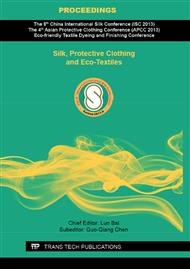p.584
p.588
p.593
p.601
p.607
p.613
p.617
p.623
p.630
Research on Thermal Protective Performance of Thermal Insulation and Flame-Retardant Protective Clothing
Abstract:
Thermal insulation and flame-retardant (TIFR) protective clothing, which has good thermal protective performance (TPP), could protect people from high-temperature or flame in casting industry, the petrochemical industry, fire industry and et al. That is, TIFR protective clothing must have certain function of slowing or restraining heat transmission, and insulating radiant heat and convection heat from high temperature heat source. The construction of TIFR protective clothing is being developed from single layer to multi-layer fabrics made by flame-retardant (FR) fibre. In this paper, based on TPP-206 tester, the TPP coefficient of single and multi-layer fabrics with flame-retardant were measured, and the TPP of TIFR protective clothing was analyzed. TPP coefficient of single fabrics included the FR viscose non-woven fabric do not meet the standard. That of all of multi-layer fabrics meet the standard requirement, and the FR viscose/wool blended fabric is not suitable for fire fighter. It is significant and the most observable effect to put the PTFE membrane between the outer layer and the insulating layer. It could improve the overall thermal protection performance.
Info:
Periodical:
Pages:
607-612
Citation:
Online since:
September 2013
Authors:
Price:
Сopyright:
© 2013 Trans Tech Publications Ltd. All Rights Reserved
Share:
Citation:


